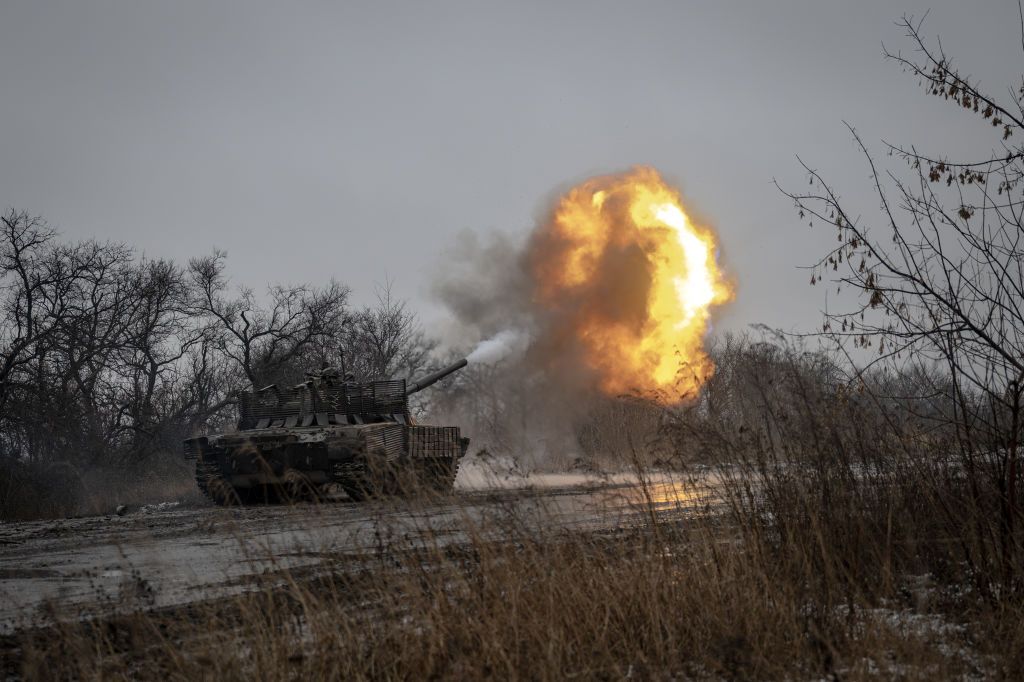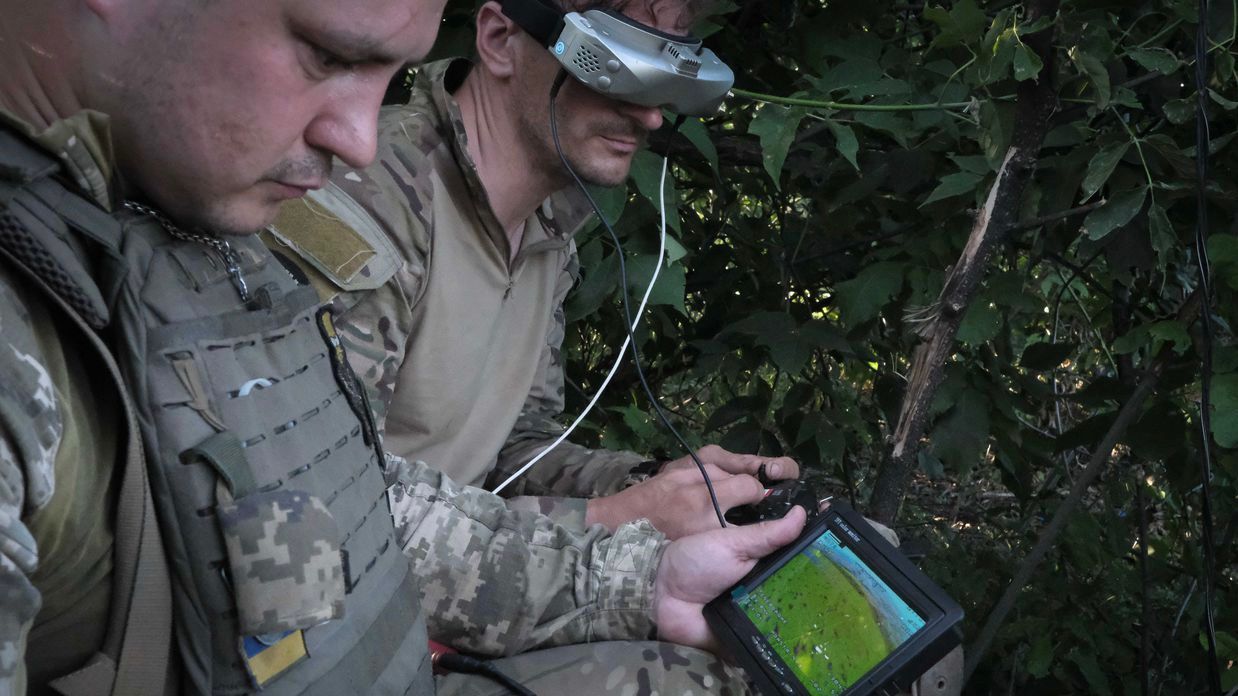Ukraine holds back Russian assault on Avdiivka as long winter battle looms

DONETSK OBLAST – “Our working hours are as follows: first you do a 12-hour shift, then another one, until you’ve done seven of these 24-hour-shifts, and that’s your week” said Oleksandr Kolesnikov, a 47-year-old surgeon, sitting hunched over on a bench-turned-overflow hospital bed at a Ukrainian stabilization point in a sleepy village in Donetsk Oblast.
“Then, when that week is over, you do another one of those weeks, then two more, and that’s your month.”
Kolesnikov, together with a small medical team, treats soldiers of the 110th Mechanized Brigade, which has stood at the forefront of Ukraine’s defense of the industrial city of Avdiivka, just north of Donetsk, occupied since 2014.
The unit has fought near Avdiivka ever since it was formed in March 2022 at the outset of Russia’s full-scale invasion, but now, the city has for the first time become the undisputed hotspot of the war.
Starting in early October, Russian forces launched a large-scale effort to overwhelm Avdiivka by encircling it from the north and south, all while bombarding the city and the settlements around it with a diverse array of artillery, air-dropped bombs, and suicide drones.
Kolesnikov, a qualified surgeon in civilian life from Rivne Oblast in northwestern Ukraine, had planned to go on 10 days of leave to see his daughter for the first time since he began serving, but the sharp uptick in work brought on by the Russian offensive meant his services were needed more than ever.

This small military medical facility, known as a stabilization point because of its job to quickly treat all kinds of wounded soldiers between their evacuation from the front line and transfer to a proper hospital, has seen an endless flow of tragedy come through its doors since it began work.
But nothing previously has compared to the intensity of the last weeks’ fighting, Kolesnikov told the Kyiv Independent.
“Sometimes you don't sleep for four days,” he said, “It's very hard mentally, when you stabilized one guy, another, a third, and the fourth dies on you.”
With the Ukrainian counteroffensive that began in summer now having clearly ended, this new intense phase of the Battle of Avdiivka is solid evidence of the overall initiative shifting back to Russia, which is now reportedly upping offensive operations in other areas, including near Kupiansk in Kharkiv Oblast, Marinka, and near Bakhmut.
Although their gains in the area have been slow and incredibly costly, Russian forces have, according to open-source assessments, crossed the railway line north of Avdiivka into the small village of Stepove.
With no signs of the offensive slowing down, comparisons to the long winter campaign for Bakhmut, where Ukrainian forces were put in an increasingly precarious position inside a city by Russian attempts to encircle it, are looking increasingly valid.
Familiar tactics
Russia’s Avdiivka offensive had started with shock and awe. After incremental Russian advances over the previous winter, by early October, the city had become a bulging salient in the front line, with Russian positions both on the northern and southern flanks less than five kilometers away from the main road into the urban area.
Reminiscent of the mindless columns of armor that tried to take Vuhledar last winter, Russian tanks and armored vehicles were churned up in their dozens by Ukrainian artillery, anti-tank fire, and FPV (first-person-view) drones.
The endless videos of “graveyards” of Russian men and equipment in the fields around Avdiivka were reflected in Ukrainian official figures on enemy losses, with daily numbers often breaking records set during the brutal battle for Bakhmut around a year earlier.
One month into the offensive, Ukrainian Commander-in-Chief Valerii Zaluzhnyi reported that over 10,000 Russian soldiers had been killed in action in the Avdiivka area alone, while over 100 tanks, 250 armored vehicles and seven Su-25 combat aircraft had also been destroyed.
As the initial failures became obvious, Russian tactics quickly changed in the second half of November to something much more familiar: slow, systematic infantry assaults of the kind that had slowly led to Russia taking the city of Bakhmut, 50 kilometers north of Avdiivka.
“If you count how many losses the soldiers of the 110th Brigade and the other units have inflicted on the enemy personnel and equipment, you have to be blind to not understand that you can't take Avdiivka in a rush like that, you have to change something,” said Anton Kotsukon, a spokesperson for the brigade, to the Kyiv Independent.
Although the Wagner mercenary group, which had pioneered such tactics in Bakhmut, is no longer in the fight, Russia has instead turned to regular mobilized troops along with Storm Z units recruited from the Russian prison system.
Just as in the case of Wagner, these assaults have been characterized by a complete lack of interest in the lives of Russian soldiers.
“In recent times, they use quite a wild tactic: they send a squad of 10-20 people into the attack, and at the same time they raise a very large number of drones into the air,” Kotsukon said. “Our artillery and other fires start to target this enemy infantry group and these drones try to see the positions where we are operating from.”
“It's a completely inhumane tactic but what can you expect from the Russians, it's not a new thing that they treat their soldiers like meat.”
Speaking to the Kyiv Independent, Caspar Grosse, a 25-year-old German-born volunteer medic in the 59th Mechanized Brigade, which fights on Avdiivka’s southern flank, said that by now, Russian armored vehicles were not used to support assaults, leaving the unexperienced infantry exposed to Ukrainian fire.
“They (Russian soldiers) get dropped off by BMPs (infantry fighting vehicles) around 300 to 600 meters from you, depending on how daring the driver is, and then straight away the BMP leaves without giving any fire support,” he said.
“Maybe three of them try and run straight back and follow the BMP; another two, on average, might get in some ditch and not move again until it's over, and those which actually have some balls will go for the assault, but they don’t make it far.”
Drones dominant
At the stabilization point of the 110th Mechanized Brigade, medical workers catch up on some sleep while waiting for the wounded. The operating theaters are closed but the corridor remains lit up as the steady hum of medical machines and distant radio chatter can be heard in the background.
The silence is broken at around 5 a.m. by the sound of a car outside and the quick call of “A wounded (soldier) has arrived!”
Propped up by a paramedic, a forty-something man in a beat-up winter uniform hobbles down the corridor. Dazed and unresponsive, with dried blood over his face and neck, he is nonetheless in one piece: just a light wound this time.
The soldier struggles to present his documents, or to answer which unit he is from exactly, but that is nothing out of the ordinary for the medics. After a short clean-up of the wounds, he leaves as quickly as he arrived.
According to the medical workers, the soldier’s wounds were likely from an FPV drone strike nearby – he has suffered minor shrapnel wounds as well as a concussion.
Three other wounded were treated that night, in a separate mobile operating theater donated outside the building. This, Kolesnikov said, was one of the quietest nights they’d had since the beginning of October.

The Kyiv Independent spent one night at the facility, located far enough away from Avdiivka to be out of range of most Russian conventional artillery, though it has been targeted with missiles on two occasions. Currently, all press access anywhere closer to the city is strictly blocked, and Russian drones are a major reason for this.
Although Ukraine led the race in drone innovation, Russia, by all accounts, has caught up, shipping Chinese drone parts into Russia in bulk and dedicating large amounts of state resources to FPV production.
As recently as a few months ago, both sides would prioritize enemy vehicles, both armored and light, for FPV drone attacks. Now, as they become more plentiful, even one individual soldier can be a target for a drone if spotted.
The upscaling of drone production is moving so quickly that the traditional wisdom of the superiority of artillery, which many experts have said will remain supreme despite the rise of FPV drones, is now being seriously challenged.
“At the moment it's about 50/50 between wounds from artillery shrapnel and FPV drones,” said Kolesnikov. ”There are just so f***ing many of them.”
On one mission, said Grosse, one of his fellow soldiers was targeted by a total of 15 enemy drones, but all failed to hit him.
“They (Russian forces) do have more, but Ukraine just uses them very effectively,” he said.
Shift to defense
As the temperature begins to hang consistently below freezing all over Ukraine, the ongoing Russian offensive on Avdiivka has heralded a new phase of the war, one that promises to be especially tough for Ukraine.
The new push to take the city came around the time Ukraine’s summer counteroffensive was understood to have culminated, and together, these two facts represent a decisive shift in the battlefield initiative towards Russia.
With future flows of Western military aid under threat both in the U.S. and in Europe, and given the disappointing results of the counteroffensive, Ukraine is slowly coming to terms with being on a defensive posture for the foreseeable future.

But with Kyiv’s political rhetoric struggling to abandon a narrative of striving to march forward and liberating more territory, concerns have been raised that Ukraine has not done enough to prepare for a long stint in defense.
Notably, prominent Ukrainian military journalist Yurii Butusov commented in an interview to NV Radio that in the Avdiivka area, despite the front line being largely stable for months before the offensive, there were little to no prepared Ukrainian defensive lines behind the first positions that were quickly overrun by Russian forces.
Given the intensity of Russian artillery fire and drone activity backing the offensive, this leaves Ukrainian troops sent into the defense with very poor options for cover, and inevitably increases the casualty rate, as several soldiers fighting there said to the Kyiv Independent.
“I don't know if it's like a lack of care or a lack of oversight. Even when we do have back-up trenches or second-line trenches, most of them are just kind of placed randomly,” said Grosse. “There are no properly built second-line trenches where you can feel like, yes, one can really hold this.”
“The Russians have their really well set-up defensive lines in the rear and that's not something we have,” he added, referring to the extensive Russian defensive lines that played a major role in stopping the Ukrainian counteroffensive.
On Nov. 30, the Ukrainian leadership finally moved to rectify the situation, with president Zelensky announcing in his evening address that Kyiv was drawing up plans to build defensive fortifications along large sections of the front line, including in the Avdiivka area.

In the meantime, casualties from the heavy fighting for this Ukrainian fortress city will likely continue to remain high for both sides, even if much higher on the Russian side.
For the Ukrainian service members now entering their second full winter on the front line of Russia’s war, the task of working non-stop throughout the colder months is immense, and inevitably comes with a mental toll.
“When I am working, I switch off from feelings, and when I am off work I cry into my pillow,” said surgeon Kolesnikov, with a kind, honest smile.
“But I won't burn out, I will come home and play with my daughter one day, and when I do, I will leave all this behind”
Note from the author:
Hi, this is Francis Farrell, cheers for reading this article. We are entering a new phase of the war, which could potentially be stranger, tougher, and more uncertain than it has ever been so far. In a time when instability around the world is growing, and attention is fading when it is needed the most, please consider supporting our reporting.














